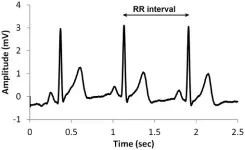Heart rate variability
Heart Rate Variability (HRV) is a measure of the variation in time between each heartbeat. HRV measures the specific changes in time (or variability) between successive heartbeats. The time between beats is measured in milliseconds (ms) and is called an R-R interval or inter-beat interval (IBI). Our heart does not tick evenly like a metronome, but instead, there is constant variation. In a normal, healthy situation, HRV is typically high when the heart is beating slowly, and low when the heart is beating faster. There is a strong correlation between the Autonomous Nervous System (ANS) and its correlation with Heart Rate Variability (HRV). This influences our respiration, exercise, stress, recovery, and other factors like our hormonal reactions, metabolic processes, and cognitive processes.

The medical significance of HRV parameters
Apart from quantifying the physical restoration and rebuilding of the body as mentioned above, there are numerous studies conducted worldwide by renowned cardiological societies, universities, and institutions that show a clear and significant relationship between HRV parameters and various risks associated with diseases ranging from blood pressure to mortality due to CVDs (CardioVascular Disorders). HRV parameters are a part of many medical scores used to find the risk level of a patient.
LF (0.04 – 0.15 Hz)
LF is a frequency domain parameter of Heart Rate Variability. LF denotes a Low-frequency respiratory band, which lies in the range of 0.04 to 0.15Hz and is recorded over a minimum of 2 minutes period. LF power is influenced by both: Parasympathetic and Sympathetic system. It is measured in milliseconds square. In resting conditions, the LF band reflects baroreflex activity and not cardiac sympathetic innervation.
Health Implications of LF
LF is highly associated with the SNS’s activity which enables the energy supply.
High LF is caused by exaggerated sympathetic activity and may lead to migraines.
Reduction of LF leads to:
- Loss of energy
- Fatigue
- Insufficient sleep
- Lethargy
HF (0.15 – 0.4 Hz)
HF is also a frequency domain parameter of Heart Rate Variability. HF denotes a high-frequency respiratory band, which lies in the range of 0.15 to 0.40 Hz and is typically recorded over a minimum of a 1-minute period. HF band is influenced by the parasympathetic activity and corresponds to the heart rate variations related to the respiratory cycle.
Health Implications of HF
This band reflects the parasympathetic activity of the ANS. Generally, an increase in HF accompanies the increase in HRV. Low HF also means reduced PNS activity.
Reduction of HF leads to:
- Chronic stress
- Aging
- Reduced electrical stability of heart
- Indigestion


